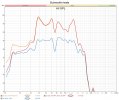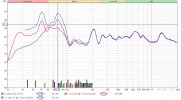Yes. Get a measurement microphone such as
UMIK-1 and start measuring. Then you can adjust the subs frequency knob (it's LPF) to match the speakers output as best as possible. This is to set the crossover point.
Your speakers will have a "natural" roll-off in the bottom end (a pseudo HPF). If you have no way to set a higher HPF, then you are stuck with what your speakers naturally produce. HPF can be set with certain analogue devices, or AVR's can do it digitally, or DSP on a PC or via a MiniDSP device can do this, and sometimes sub's have analogue outputs to handle this. Does your sub have RCA input and output? If so, it might do a matching HPF on the outputs, and so it would be good to wire it in between source and speaker amp. If not and you have no other means, then you get what you get with your speakers. BUT, if your speakers have ports, you might consider blocking those ports with a rolled sock or something. Blocking the port will reduce the speakers low frequency response a small amount (not a problem because the sub can do it), and it should improve the distortion characteristics of the bass that it does still put out.
Subwoofers operate in the audio zone that is extremely affected by the rooms size and the subs position within the room, and this phenomenon is known as
speaker boundary interference response (SBIR). So if you can move about your sub and/or listening positioning, you might be able to get a better response than just "where ever you have it". There are techniques for finding good positions such as the "
Bass Hunter Technique" from
Acoustics Insider Youtube channel.
Because whilst you can get your subs controls set roughly by ear, you might get "tricked". You might adjust them in such a way that you have more bass than ever at 80Hz and think that that is great, but you might be boosting right on a room mode and/or speaker peak and making too much bass. This might sound impressive at first, but overtime you might come to realise it is too boomy or something. Similarly, if a peak at one frequency is like 10dB louder than the surrounding frequencies, it can have the effect of "shadowing" those frequencies (it makes them stand out less than they should). A measurement mic will reveal all this with no guess work.
As an example, I have a ****** subwoofer that puts out a lower SPL response from 25-45Hz, and a higher response above 50Hz. The attached gold measurement* shows these 2 shelves, but also a bunch of SBIR related issues (big peaks at 50, 70, 85, and 125, and nulls at 75 and 105). [*Ignore the red and blue ones, that was me fiddling around with DSP].

Yesterday I was trying to integrate this sub with some speakers,
as stated in this thread. The speakers response drops from 60Hz, but actually I think that is also an SBIR peak, so maybe they are managing fairly flat to 50Hz (but there is a big suck-out from 100-200Hz, so maybe not). You can see the speaker only response in purple. Then I added the sub with the "frequency control" knob set at ~1/3rd, and this measurement is the pink one. You can see the sub has added 2 peaks at 50 and 77 Hz, whilst also filling up the area from 25-45Hz. I then turned the frequency up to ~2/3rds, but this added way too much bass (made those peaks too extreme).

Ideally I would have put a HPF on the speakers at ~90Hz, which would have removed their contribution to bass in the 60-80Hz range, reducing those peaks. Alas, I was limited by my available hardware, as you might be? If I had a quality sub that could play high with low passed outputs, it will probably be better for me to cross at ~150Hz, so the sub could fill in that hole from 100-200Hz.


